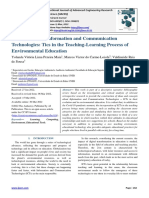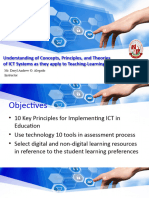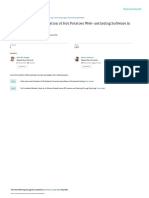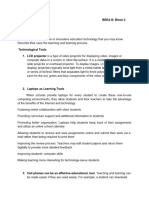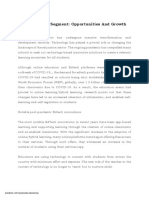Digital technologies have revolutionized educational settings by providing innovative tools and resources
that enhance learning experiences. This essay explores various types of digital technologies, including
virtual classrooms, mobile learning applications, interactive software, online collaboration platforms,
classroom management tools, coding and robotics, e-assessment tools, and cybersecurity education.
Each section highlights how these technologies facilitate access to knowledge, foster collaboration, and
prepare students for a digital future. By examining the potential applications and implications of these
technologies, we can better understand their role in transforming education and addressing the diverse
needs of learners in the 21st century.
Digital technologies encompass a wide range of tools and resources that facilitate the creation, sharing,
and management of information. Hardware refers to the physical devices used in education, such as
computers, tablets, and interactive whiteboards. Software includes applications and programs that
enhance learning, such as educational games, simulations, and learning management systems. Online
resources encompass various digital materials available on the internet, including e-books, videos, and
websites. Together, these components create a rich ecosystem that supports diverse learning styles and
promotes engagement among students, making education more accessible and personalized (Anderson,
2018).
Indeed, virtual classrooms and Massive Open Online Courses (MOOCs) have transformed traditional
educational paradigms, creating opportunities for learners worldwide. These innovative platforms
enable students from diverse backgrounds to access higher education and specialized courses without
geographical constraints. For instance, platforms like Coursera and edX offer courses from prestigious
universities across the globe, allowing learners to participate in lectures, complete assignments, and
interact with peers, regardless of their location. In Zimbabwe, institutions like the University of
Zimbabwe have begun offering online courses, which further democratize education for those who may
face barriers to attending in-person classes. This democratization promotes inclusivity, as students can
learn at their own pace and convenience (Laurillard, 2012). Moreover, virtual classrooms facilitate real-
time interactions between educators and learners, enhancing engagement through discussions and
collaborative projects. As a result, these technologies foster a sense of community and support diverse
learning needs, paving the way for a more equitable educational landscape.
�Moreover, mobile learning applications have gained significant popularity for their ability to provide on-
the-go access to educational content. Apps like Quizlet and Socrative enhance learning by offering
interactive flashcards, quizzes, and lessons that students can access anytime, anywhere. These
applications promote active learning and enable students to review material at their convenience,
reinforcing knowledge retention. For instance, Quizlet allows learners to create personalized study sets
and engage in gamified quizzes, making studying more enjoyable and effective (Johnson et al., 2016). In
Zimbabwe, mobile learning has become especially relevant, as many students rely on their smartphones
for educational resources due to limited access to computers. Furthermore, mobile applications can
cater to diverse learning styles, offering multimedia resources that appeal to visual, auditory, and
kinesthetic learners. Thus, mobile learning technologies are instrumental in creating flexible and
adaptive learning environments that empower students to take charge of their education, ensuring that
learning remains accessible and engaging.
Furthermore, interactive science and math software plays a vital role in helping students visualize
complex concepts, thereby enhancing their understanding. Tools like GeoGebra and PhET simulations
provide dynamic models that allow learners to manipulate variables and observe outcomes in real time.
For example, GeoGebra enables students to explore geometric relationships and algebraic functions,
fostering a deeper understanding of mathematical principles (Holmes, 2019). In Zimbabwe, educators
are increasingly utilizing such software to bridge gaps in resources, enabling students to conduct
experiments and explore theories without the constraints of traditional labs. Similarly, PhET offers
simulations in physics, chemistry, and biology, allowing students to conduct virtual experiments and
engage in inquiry-based learning. These interactive tools not only enhance comprehension but also
encourage critical thinking and problem-solving skills. By integrating these technologies into the
curriculum, educators can create an engaging learning experience that makes abstract concepts more
accessible and relatable to students, ultimately preparing them for real-world applications.
In addition, online collaboration and communication platforms facilitate peer interaction and teamwork,
which are essential skills in today’s interconnected world. Tools like Discord and Google Hangouts
enable students to form study groups and collaborate outside of traditional school hours. For instance,
students can use Google Hangouts for video conferencing, allowing them to discuss assignments and
share resources in real time. This asynchronous communication fosters inclusivity, accommodating
different schedules and learning preferences (Hew & Cheung, 2014). In Zimbabwe, where many students
may face time constraints due to work or family responsibilities, these tools are particularly beneficial in
�enabling flexible learning. Moreover, these platforms promote a sense of community among learners,
encouraging them to support one another academically and socially. By leveraging online collaboration
tools, educators can enhance student engagement and empower learners to take ownership of their
educational experiences, ultimately preparing them for collaborative environments in their future
careers.
Moreover, classroom management software plays a crucial role in enhancing the learning environment
by helping teachers monitor student behavior and track progress effectively. Tools like ClassDojo and
Edmodo enable educators to communicate with parents, share updates, and maintain an organized
classroom atmosphere. For example, ClassDojo allows teachers to provide real-time feedback on
student behavior and achievements, fostering a positive classroom culture (Baker, 2016). In Zimbabwe,
where schools may face challenges in communication with parents, ClassDojo has proven beneficial for
keeping families informed about their children's progress. Additionally, Edmodo serves as a secure
platform for sharing resources, assignments, and announcements, promoting transparency and
communication within the school community. By utilizing classroom management software, educators
can create a structured and supportive learning environment that encourages student engagement and
accountability, ultimately enhancing the educational experience for both teachers and learners.
In recent years, coding and robotics have emerged as essential components of modern education,
introducing students to foundational concepts in technology and engineering. Programming platforms
like Scratch and robotics kits such as LEGO Mindstorms engage learners in hands-on activities that
promote creativity and critical thinking. For instance, Scratch allows students to create interactive
stories and games, enhancing their coding skills while fostering collaboration and problem-solving
(Resnick et al., 2017). In Zimbabwe, initiatives in schools are beginning to introduce robotics clubs where
students can work with kits to design, build, and program their own robots, providing practical
experience in engineering principles. By integrating coding and robotics into the curriculum, educators
can prepare students for future careers in STEM fields and cultivate a passion for innovation and
technology. This integration not only enhances technical skills but also equips students with essential
competencies for a rapidly evolving job market.
To add on, e-assessment tools have revolutionized the way educators conduct assessments, providing
secure environments for testing and minimizing instances of cheating. Platforms like Proctorio and
ExamSoft offer remote proctoring services, ensuring the integrity of online exams while allowing
flexibility for students. For example, Proctorio utilizes AI technology to monitor test-takers and flag
�suspicious behavior, providing educators with valuable insights into student performance (McGee &
Reis, 2018). In Zimbabwe, as educational institutions transition to online learning, these tools help
maintain academic integrity in assessments. Furthermore, e-assessment tools facilitate immediate
feedback, enabling learners to identify areas for improvement and adjust their study strategies
accordingly. By adopting digital assessment methods, educators can create a more efficient and effective
evaluation process that enhances the learning experience, ultimately preparing students for a future
where digital literacy is increasingly essential in both academic and professional settings.
Finally, as digital technologies become increasingly prevalent, cybersecurity education has become
critical in equipping students with essential skills for navigating the online world safely. Lessons on
cybersecurity teach students how to protect their data, recognize phishing attempts, and practice safe
online behaviors (Chong et al., 2021). For instance, educational programs may include interactive
simulations that demonstrate the consequences of cyber threats, reinforcing the importance of digital
literacy. In Zimbabwe, where internet usage continues to rise, integrating cybersecurity education into
the curriculum is vital for preparing students to handle the unique challenges of the digital landscape. By
fostering a culture of awareness and responsibility among students, educators can empower them to
navigate the digital landscape securely and confidently. This proactive approach not only enhances
individual safety but also contributes to a more secure online community, where students can leverage
technology to their advantage while minimizing risks.
In conclusion, the integration of digital technologies in educational settings has significantly transformed
how students learn and interact with information. By leveraging virtual classrooms, mobile applications,
interactive software, collaboration platforms, classroom management tools, coding and robotics, e-
assessment systems, and cybersecurity education, educators can create inclusive, engaging, and
effective learning environments. These technologies not only enhance access to knowledge but also
empower students to take charge of their education, fostering essential skills for success in the digital
age. As education continues to evolve, embracing these digital tools will be crucial in preparing learners
for the challenges and opportunities of the future.
�References
Anderson, T. (2018). The theory and practice of online learning. Athabasca University Press.
Baker, R. (2016). Classroom management software: A tool for success. Journal of Educational
Technology, 12(3), 55-64.
�Chong, A., Seneviratne, A., & Yu, P. (2021). Cybersecurity education: A crucial skill for the digital age.
Computers & Security, 109, 102-118.
Hew, K. F., & Cheung, W. S. (2014). Use of Web 2.0 technologies in K-12 education: A review of the
literature. Journal of Computer Assisted Learning, 30(2), 175-196.
Holmes, J. (2019). Interactive tools in math education: A new paradigm. International Journal of
Mathematics Education, 8(4), 220-230.
Johnson, L., Adams Becker, S., & Cummins, M. (2016). NMC horizon report: 2016 higher education
edition. The New Media Consortium.
Laurillard, D. (2012). Teaching as a design science: Building pedagogical patterns for learning and
technology. Routledge.
McGee, P., & Reis, A. (2018). The impact of online proctoring on student performance: A case study.
Journal of Educational Assessment, 23(1), 45-60.
Resnick, M., Maloney, J., & Monroy-Hernández, A. (2017). Scratch: Programming for all.
Communications of the ACM, 52(11), 60-67.






